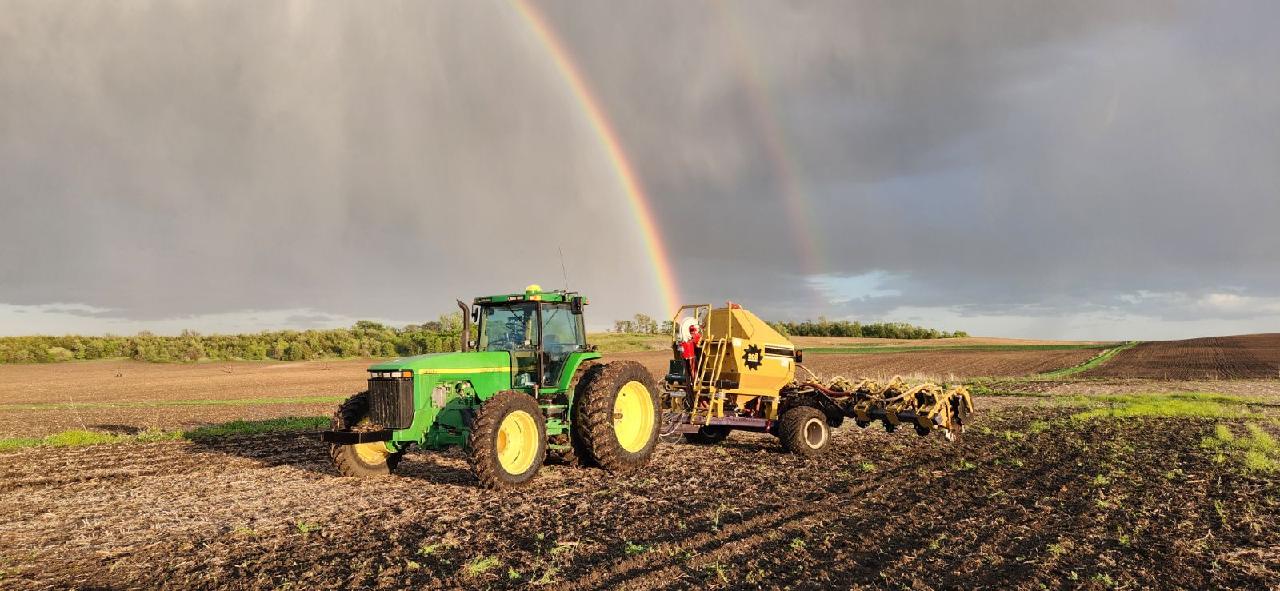On this episode of Conservation Ag Update, brought to you by Martin-Till, find out how several no-tillers are handling a wet month across parts of the Corn Belt. Central Illinois no-tiller Dave Brown is patiently waiting for Mother Nature to cooperate before he can finish up planting several hundred acres, while Wisconsin no-tiller Tyler Troiola deals with a tractor glitch and a 2-inch rain event in one day.
Robert Boyle would love some of that rain in Coolidge, Ariz. He shows off a new piece of precision technology that’s helping him make strip-till and cover crops work with only 7 inches of rain per year.
In the Cover Crop Connection, associate editor Mackane Vogel explores alternative cover crop options for no-tillers in colder climates.
Also in the episode, veteran agronomist Ken Ferrie checks in from rain-soaked Illinois, where no-till is proving its worth on a field that received 5 inches of rain in less than 4 days. Plus, Washington, Iowa, no-tiller Mitchell Hora explains how low-carbon corn could yield serious cash for his fellow no-tillers and more!
This episode of Conservation Ag Update is brought to you by Martin-Till.
Our customers believe that Martin-Till®️ products provide an excellent return on their investment. We know this because a large percentage of them are repeat customers since the beginning in 1991. Our planter attachments help make it possible to plant into higher levels of residue and moisture. Higher levels of mulch means less erosion, improved soil tilth and fertility, which can reduce production costs.
Martin-Till’s goal is to increase yields and save you time and money. We hope you find something from our product offerings of row cleaner, UMO’s, closing wheels systems and recently added concaves that will make this year’s planting & harvesting go better for you. After all, you deserve the best!
TRANSCRIPT
Jump to a section or scroll for the full episode...
- #Plant24 Update: “It’s Showtime” Despite Shaky Weather
- #Plant24 Update: No-Tiller Deals with Challenging Spring
- Making Cover Crops & Strip-Till Work with 7 Inches of Rain
- Hairy Vetch, Triticale & Other Alternatives to Cereal Rye
- No-Till Improves Water Infiltration after 5-Inch Rainfall
- How No-Tillers Can Cash in on 40B Tax Credit
- Photo of the Week: Strip-Till Pot O’ Gold
#Plant24 Update: “It’s Showtime” Despite Shaky Weather
Planting season rolls on with 49% of corn planted according to the May 13th USDA Crop Progress report. That’s 5% behind the 5-year national average. As WAND News reporter Deron Molen shows us, some no-tillers like Dave Brown in central Illinois, are still patiently waiting for Mother Nature to cooperate.
“I take a small seed, and I grow it into bushels. It’s all I’ve ever really known.”
David Brown’s central Illinois roots run deep.
“We’ve farmed some of the same soils since 1867.”
But his crops are still waiting to take root as he waits for better weather.
“We need a good hard week to get things done, and ideal conditions. We’re starting to look at the calendar and saying, ‘It’s showtime.’
Constant rounds of showers have left farmers starting and stopping this planting season as they wait for their fields to dry out. And when the water recedes and the mud returns to soil, work kicks into overdrive.
“The Illinois farmer can probably plant up to 10% a day of their crop. That can even be pushed more if you work longer hours, and that’s probably what we’ll be doing.”
The good news is Brown and other farmers aren’t in danger of losing too much of their yields if they get the seeds in the ground this week. But his yield can still start to drop if the forecast doesn’t give him a window for the hundreds if not thousands of acres that remain.
“The forecast I’m looking for is a period of dry weather. We’ll keep planting until we think we’re wasting our time.”
But Brown has endured the test of time before, otherwise he wouldn’t still be here, growing his family’s roots in the region he loves so much.
“It means so much to me and my family that we have history and continuity.”
Brown does some minimum tillage on corn, but he no-tills almost all his soybeans, which puts him in a better spot moisture wise than many of his conventional counterparts.
#Plant24 Update: No-Tiller Deals with Challenging Spring
It’s a similar story in southeastern Wisconsin, where longtime no-tiller Tyler Troiola just got almost 2 inches of rain in one day. Throw in a tractor glitch, and it’s been a challenging spring so far. But thanks to no-till, Tyler’s fields aren’t completely covered in puddles.
“We’ve had field days before where they come out and do water infiltration tests and you just go across the fence line and it's a giant difference. We've already had an inch and a half of rain today and you drive around, there's not a lot of puddles. I mean there's some, but it definitely makes a difference.”
“There are certain parts of the state that are a little behind, but we had a couple breakdowns early in season. It slowed us down. We upgraded our corn planter this year and then it turns out our tractor had a hidden glitch in it that we just found from updating the planter. That cost us 3 or 4 days. Got that fixed. We’re doing OK. It just needs to dry out a little bit.”
Corn planter wasn’t his only upgrade, Tyler’s also trying John Deere See & Spray Premium for the first time. We’ll check back in with him in June to see how it goes.
Making Cover Crops & Strip-Till Work with 7 Inches of Rain
I’ll tell you one guy who’d love to get some of this rain we’ve been talking about, is Robert Boyle. He only gets about 7 inches of rain out in Coolidge, Ariz. But that’s not stopping him from using cover crops and strip-till. Robert, what’s going on?
“I’ll be talking this year at the Strip-Till Conference about strip-tilling in adverse conditions, reducing passes, saving water. This field of corn is a month old. It will be irrigated with a new Rain 360 unit. We’re going to start implementing banded water instead of full irrigation. Just looking at multiple ways to improve the bottom line and cut out any extra passes through the field, and making us more efficient.”
Looking forward to seeing Robert at the National Strip-Tillage Conference, Aug. 8-9 in Madison, Wis. Head to StripTillConference.com to reserve your spot and cash in on early bird registration savings.
Hairy Vetch, Triticale & Other Alternatives to Cereal Rye
This week we’re going to hear from USDA research agronomist Jose Franco as he discusses alternatives to only using cereal rye as a winter cover crop in the Upper Midwest. Some of these alternatives include triticale, hairy vetch and winter camelina. Here’s what Franco and his team of researchers are looking for with those trials.
“We’re interested in a few different things. We want to diversify so that we can potentially reduce any negative impact on the next corn crop. So we are working in a corn silage system so, our corn on corn rotation. So we are planting these cover crops after corn silage harvest, we are applying dairy manure, and then the next year we are harvesting them for forage and then planting another corn crop to see the response of that corn crop. So, we want to see if diversifying them and reducing that proportion of cereal rye has any potential benefit to the next corn crop. We are looking at the pollinators with the winter camelina and we are looking at the nutrient uptake with these different cover crop species and mixtures. So we are looking at soil nitrates as an indirect measurement of water quality. And then when rye hits the boot stage we are harvesting all these cover crops for forage, so we’ll look at productivity. So we are looking at forage yields as well as running a series of nutrient value/forage quality metrics on them.”
You can head to covercropstrategies.com to learn more about these alternative cover crops that Franco and his team are studying.
No-Till Improves Water Infiltration after 5-Inch Rainfall
Continuing the wet spring theme now from earlier in the show, veteran agronomist Ken Ferrie checks in from rain-soaked Illinois, where no-till is proving its worth on a field that received 5 inches of rain in less than 4 days.
“I’ve seen in many cases where a good no-till program literally eliminates the need for waterways, terraces and some of the stuff we had to use when we’re using such massive amounts of tillage. Now, that doesn’t mean every field can be fixed with no-till, but it is something where we see it, and we see it a lot. If you still have slopes, and you’re still fighting erosion in no-till, you’re going to have to bring in those waterways and think about terraces or cover crops. It’s pretty amazing how many of the fields here in Illinois that we can almost fix the erosion issue by just moving them into a longer term no-till program.”
How No-Tillers Can Cash in on 40B Tax Credit
Federal incentives to lower greenhouse gas emissions could result in a windfall for no-tillers who are already raising low-carbon corn for ethanol. Sustainable aviation fuel, referred to as SAF, is eligible for a tax credit under Section 40B. An update to guidelines for the tax credit requires farmers to use no-till, cover crops and efficient nitrogen fertilizer for the corn being turned into ethanol in order for the fuel to qualify for a tax credit. Washington, Iowa, no-tiller and Continuum Ag founder Mitchell Hora explained some of the tax credit math in a recent webinar.
“I believe that for 60 cents a bushel, split up amongst all the different players, I just don’t know that the juice is going to be worth the squeeze. That’s the bundle approach of bundling cover crop, no-till and efficiency enhancing fertilizer, and only allocating 10 CI points. In reality, with the GREET model, doing those practices for most counties would lower your CI score by closer to 30 points, which is like what it’s done on my farm. We’re 33 points lower than the county default. Say that instead of giving 10 points it’s 30 points, triple these numbers, now I think we can make some headway and get more farmers to participate, more farmers brought into this soil health space.”
More detailed information about the tax credit on No-TillFarmer.com
Photo of the Week: Strip-Till Pot O’ Gold
And let’s put a bow on the show …or should I say...rainbow…with our Photo of the Week.

Check it out. An ETS SoilWarrior strip-till machine looking more like a pot of gold at the end of a rainbow. The Peterson family snapped this award-worthy photo on their farm in southeastern Minnesota. Hang it in the Louvre.
That will wrap things up. Have an interesting photo or video from your farm? Or a story you’d like us to feature on the broadcast? Send me an email at Nnewman@lesspub.com.
And that will wrap things up this edition of Conservation Ag Update. Until next time, for more stories visit no-tillfarmer.com, striptillfarmer.com and covercropstrategies.com. Thanks for stopping by. Have a great day!








